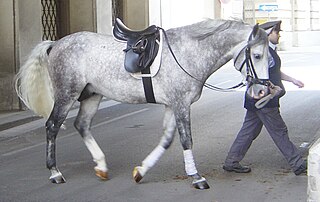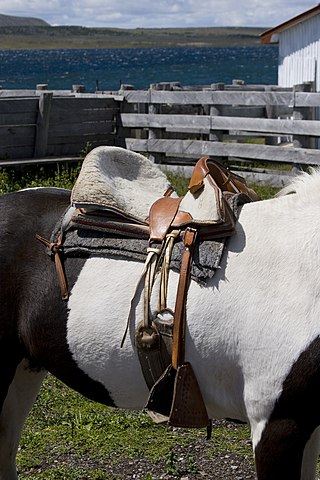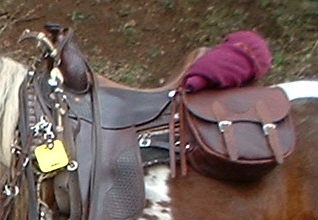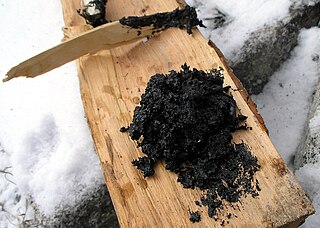
Leather is a strong, flexible and durable material obtained from the tanning, or chemical treatment, of animal skins and hides to prevent decay. The most common leathers come from cattle, sheep, goats, equine animals, buffalo, pigs and hogs, and aquatic animals such as seals and alligators.

Patent leather is a type of coated leather that has a high-gloss finish.

English saddles are used to ride horses in English riding disciplines throughout the world. The discipline is not limited to England, the United Kingdom in general or other English-speaking countries. This style of saddle is used in all of the Olympic and International Federation for Equestrian Sports (FEI) equestrian disciplines, except for the newly approved FEI events of equestrian vaulting and reining. Most designs were specifically developed to allow the horse freedom of movement, whether jumping, running, or moving quickly across rugged, broken country with fences. Unlike the western saddle or Australian Stock Saddle, there is no horn or other design elements that stick out above the main tree of the saddle.

Western saddles are used for western riding and are the saddles used on working horses on cattle ranches throughout the United States, particularly in the west. They are the "cowboy" saddles familiar to movie viewers, rodeo fans, and those who have gone on trail rides at guest ranches. This saddle was designed to provide security and comfort to the rider when spending long hours on a horse, traveling over rugged terrain.

Neatsfoot oil is a yellow oil rendered and purified from the shin bones and feet of cattle. "Neat" in the oil's name comes from an Old English word for cattle. Neatsfoot oil is used as a conditioning, softening and preservative agent for leather. In the 18th century, it was also used medicinally as a topical application for dry scaly skin conditions.

Mink oil is an oil used in medical and cosmetic products. It is obtained by the rendering of mink fat which has been removed from pelts bound for the fur industry.

Chamois leather is a type of porous leather, traditionally the skin of the chamois, a type of European mountain goat, but today made almost exclusively from the flesh split of a sheepskin.

Dubbin is a greasy or waxy product used to soften, condition, and waterproof leather. It has been used since medieval times to waterproof and soften leather goods. It differs from saddle soap used to clean and lightly condition leather, or shoe polish, which is used to impart shine and colour to it.
Conditioners used on leather take many shapes and forms. They are used mostly to keep leather from drying out and deteriorating.

A girth, sometimes called a cinch, is a piece of equipment used to keep the saddle in place on a horse or other animal. It passes under the barrel of the equine, attached to the saddle on both sides by two or three leather straps called billets. Girths are used on Australian and English saddles, while western saddles and many pack saddles have a cinch, which is fastened to the saddle by a single wide leather strap on each side, called a latigo.

Brooks England is a bicycle saddle manufacturer originally based in Smethwick, West Midlands, England and now owned by Selle Royal of Italy. It has been making leather goods since 1866, when it was founded in Hockley, Birmingham. In the 1880s, the production of bicycle saddles began, the first saddle patent having been filed in 1882. In a 2014 interview with Feel Desain, a Brooks spokesperson stated that according to family legend, the company began when founder John Boultbee Brooks, a horse saddle manufacturer, tried to use a bicycle after his horse died but found the wooden seat very uncomfortable. As a result, he vowed to set about solving this problem and Brooks was born.

Saddlebags are bags that are attached to saddles.

Murphy Oil Soap is an American brand of cleaning product that is manufactured by Colgate-Palmolive. In 1910, Jeremiah Murphy, director of the Phoenix Oil Company, bought the formula for Murphy Oil Soap from a recent immigrant from Germany. The soap, with its potassium vegetable oil base, and no phosphates, proved to be very popular in Ohio. The company continued to be run by the Murphy family for 80 years, when they sold it to Colgate. It is available in a concentrated liquid form which is then mixed with water, as well as pre-diluted form which comes in a trigger spray bottle. Commercials for the product state that the product is ideal for cleaning wood surfaces.

A saddle is a supportive structure for a rider of an animal, fastened to an animal's back by a girth. The most common type is equestrian. However, specialized saddles have been created for oxen, camels and other animals. It is not known precisely when riders first began to use some sort of padding or protection, but a blanket attached by some form of surcingle or girth was probably the first "saddle", followed later by more elaborate padded designs. The solid saddle tree was a later invention, and though early stirrup designs predated the invention of the solid tree, the paired stirrup, which attached to the tree, was the last element of the saddle to reach the basic form that is still used today. Today, modern saddles come in a wide variety of styles, each designed for a specific equestrianism discipline, and require careful fit to both the rider and the horse. Proper saddle care can extend the useful life of a saddle, often for decades. The saddle was a crucial step in the increased use of domesticated animals, during the Classical Era.
British Museum leather dressing has been used by many conservators since its publication to protect and conserve leather.

A horse harness is a device that connects a horse to a horse-drawn vehicle or another type of load to pull. There are two main designs of horse harness: (1) the breast collar or breaststrap, and (2) the full collar or collar-and-hames.

Birch bark tar is a substance that is synthesized by dry distillation of birch tree bark.

Kura (鞍) is the generic name for the Japanese saddle. The word "kura" is most commonly associated with the saddle used by the samurai class of feudal Japan. Over time the Japanese added elements of their own until the Japanese saddle became an identifiable style, also known as the samurai saddle.
The conservation and restoration of leather objects is the process of determining the causes of deterioration, followed by deciding the best course of action for preserving the leather objects for the future.















